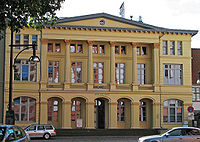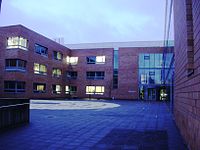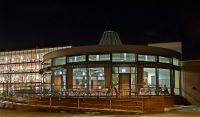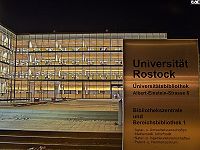- University of Rostock
-
University of Rostock Universität Rostock 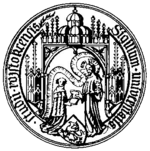
Seal of the University of RostockLatin: Universitas Rostochiensis Motto Traditio et Innovatio Motto in English Tradition and innovation Established 13 February 1419 Type Public Chancellor Joachim Wittern Rector Professor Wolfgang D. Schareck[1] (906th rector) Admin. staff 2.634 (2007) Students 14.000 (2007) Location Rostock, Germany Campus Urban Affiliations EUA Website www.uni-rostock.de Central building, University of Rostock The University of Rostock (German: Universität Rostock) is the university of the city Rostock, in the German state of Mecklenburg-Vorpommern.
Founded in 1419, it is the oldest and largest university in continental northern Europe and the Baltic Sea area. It is the third oldest university in Germany in continuous operation.
Contents
History
It was founded in 1419 by confirmation of Pope Martin V and thus is one of the oldest universities in continental Northern Europe. In Germany, there are only five older universities: Heidelberg (1386), Cologne (1388), Erfurt (1392/1994), Würzburg (1402/1582) and Leipzig (1409).
Throughout the 15th century, the University of Rostock had about 400 to 500 students each year, a large number at that time. Rostock was among the largest universities in Germany at the time and many of its students also came from the Low Countries, Scandinavia or other states bordering the Baltic Sea.
In the course of political struggles and pressure from the church, the university moved to Greifswald in 1437 and remained there until 1443. From 1487 to 1488 teaching took place in Lübeck.
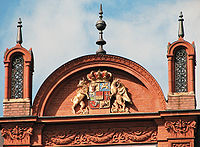 Detail of the central building depicting the coat of arms of Mecklenburg-Schwerin
Detail of the central building depicting the coat of arms of Mecklenburg-Schwerin
A few years later the city of Rostock, its university also became Protestant in 1542. Humanism and Lutheranism were defining characteristics of the university. After the Thirty Years' War (1618-1648), the University of Rostock played only a regional role. When the "ownership" of the university moved from the city to the state (Grand Duchy Mecklenburg-Schwerin) in 1827, however, things changed for the better. The end of the 19th century saw generous building activity in Rostock's alma mater and the university soon regained its old reputation amongst German universities.
On the occasion of the 500th anniversary of the university, Albert Einstein and Max Planck received honorary doctorates on 12 November 1919. This made the University of Rostock the world's first institute of higher learning to award this honour to Einstein. Interestingly enough, the doctorate was not revoked during the Nazi rule in Germany (1933-1945), despite such orders by the Nazis. The reason for this remains unknown.
The end of the Second World War in 1945 brought many changes. The university, now finding itself in the Soviet Zone of Germany (the later German Democratic Republic), was re-opened on 24 February 1946. The Faculty of Law was closed in 1951, a Faculty of Agriculture was introduced in 1950 and in 1951 saw the opening of a Department of Shipbuilding (renamed Faculty of Technology in 1963). The University of Rostock was the first traditional university in Germany to open a technical faculty. In 1952, the Faculty of Aviation was opened, but eventually relocated to Dresden.
In 1976 the university was renamed Wilhelm-Pieck-Universität after Wilhelm Pieck, the first president of the German Democratic Republic. The renaming was annulled after the German reunification.
In 1978, the university engaged in a partnership with the Cochin University of Science and Technology (CUSAT), to help design the course structure and support the development of the Department of Ship Technology at CUSAT. Also, a group of Rostock faculty members were sent to Cochin University of Science and Technology to improving the university's teaching facilities, remaining there until the late 1980s. The prominent place of Cochin University of Science and Technology's Department of Ship Technology in the world maritime industry is thus largely credited to the extensive support of the University of Rostock.
People
In nearly six centuries numerous notable students and professors have had ties with the university, for instance:
- Tycho Brahe, Danish astronomer
- Carl Friedrich Wilhelm Brockmann, philosopher (PhD in 1848)
- Albert Einstein, honorary Doctor of Medicine, 1919[2]
- Arno Esch (1928-1951), student and liberal politician
- Karl von Frisch, ethologist and Nobel Prize laureate
- Konrad Gesselen from Geismar, Hesse, astronomer, mathematician, pastor, taught at Rostock and Thorn, wrote Cisiojanus
- Walter Hallstein (1901–1982), first President of the European Commission
- Walter Kempowski, writer
- Albrecht Kossel, medical scientist and Nobel Prize laureate (PhD 1878)
- Max Planck, honorary doctorate, 1919
- Isaac Rülf, philosopher, humanitarian organizer, author (PhD in 1865)
- Moritz Schlick, philosopher
- Heinrich Schliemann, archeologist (PhD in 1869)
- Rudolf Steiner, anthroposophist (PhD in 1891)
- Otto Stern, physicist
Structure
Like many continental European universities, the University of Rostock is divided into academic faculties (German: Fakultät). Those can be sub-divided into academic departments (German: Institut) and chairs (German: Lehrstuhl).
Faculties/Schools
It is divided into the following nine faculties:
- evangelical theology
- philosophy (and arts)
- mathematics and natural sciences
- law
- engineering
- agriculture and environmental sciences
- medicine
- economic and social sciences
- electrical engineering and informatics
Research
The university co-operates with several independent research centres. Among those:
- Leibniz Institute for Atmospheric Physics at Kühlungsborn
- Leibniz Institute for Baltic Sea Research at Warnemünde
- Leibniz Institute for the Biology of Farm Animals at Dummerstorf, in co-operation with the German federal government
- Leibniz-Institut]] for Catalysis
- Max Planck Institute for Demographic Research
- Fraunhofer-Institut for Graphic Data Processing
The University Clinic of Rostock
The university operates a teaching and research hospital, The University Clinic of Rostock.[3]
The hospital operates several teaching and research institutes. Among those:
- Albrecht Kossel Institute for Neuroregeneration
Points of interest
- Botanischer Garten Universität Rostock, the university's botanical garden
Partner Universities
Although cooperation and student exchanges are possible with many more institutions, the university has signed cooperation agreements with the following international universities:
Europe
 Charles University in Prague, Czech Republic
Charles University in Prague, Czech Republic University of Zagreb, Croatia
University of Zagreb, Croatia University of Copenhagen, Denmark
University of Copenhagen, Denmark University of Turku, Finland
University of Turku, Finland University of Nantes, France
University of Nantes, France University of Latvia, Latvia
University of Latvia, Latvia Gdańsk University, Poland
Gdańsk University, Poland Saint Petersburg State University, Russia
Saint Petersburg State University, Russia University of Kristianstad, Sweden
University of Kristianstad, Sweden Newcastle University, UK
Newcastle University, UK
World
 National University of La Plata, Argentina
National University of La Plata, Argentina University of Saskatchewan, Canada
University of Saskatchewan, Canada University of Guelph, Canada
University of Guelph, Canada Science University of Tokio, Japan
Science University of Tokio, Japan North-West University, South Africa
North-West University, South Africa University of Georgia, United States
University of Georgia, United States Brown University, United States
Brown University, United States University of Utah, United States
University of Utah, United States Arab International University (AIU), Syria
Arab International University (AIU), Syria University of Wyoming, United States
University of Wyoming, United States University of Alabama in Huntsville, United States
University of Alabama in Huntsville, United States
References
- ^ Prof. Wolfgang Schareck ist der neue Rektor der Universität Rostock
- ^ http://www.einstein-website.de/z_information/honours.html#rostock
- ^ "Universitätsklinikum Rostock". University of Rostock. 2011. http://www.med.uni-rostock.de/index.php?id=273. Retrieved 13 August 2011.
External links
- University of Rostock
- City of Rostock
- University of Rostock - Short history in the Catholic Encyclopedia
- Albrecht-Kossel-Insitut für Neuroregeneration
See also
- List of medieval universities
- List of universities in Germany
- List of oldest universities in continuous operation
- Medieval university
- City of Rostock
Universities in the North of Germany Traditional universities New universities FU Berlin · Bremen · Bremen (Jacobs University) · Flensburg · Hamburg (HSU) · Hildesheim · Lübeck · Lüneburg · Oldenburg · Osnabrück · Potsdam · VechtaUniversities of Technology Universities University of Greifswald · University of Rostock
Colleges Fachhochschule Stralsund · Hochschule Wismar · Hochschule Neubrandenburg · Hochschule für Musik und Theater Rostock · Baltic College Güstrow · Fachhochschule für öffentliche Verwaltung, Rechtspflege und PolizeiCategories:- University of Rostock
- 1419 establishments
- Educational institutions established in the 15th century
- Universities and colleges in Mecklenburg-Vorpommern
Wikimedia Foundation. 2010.


